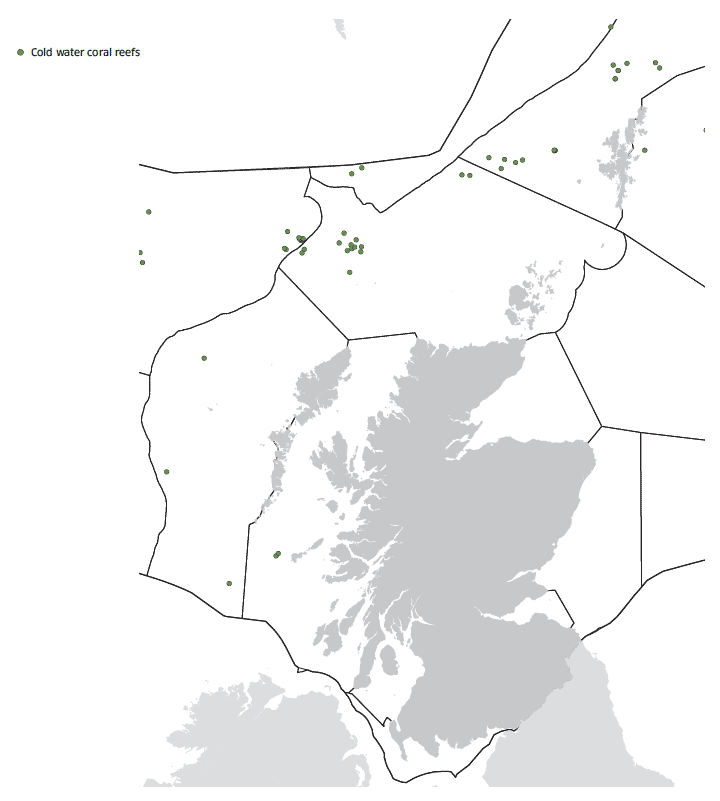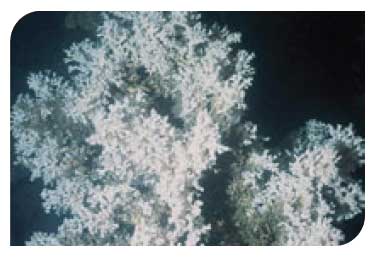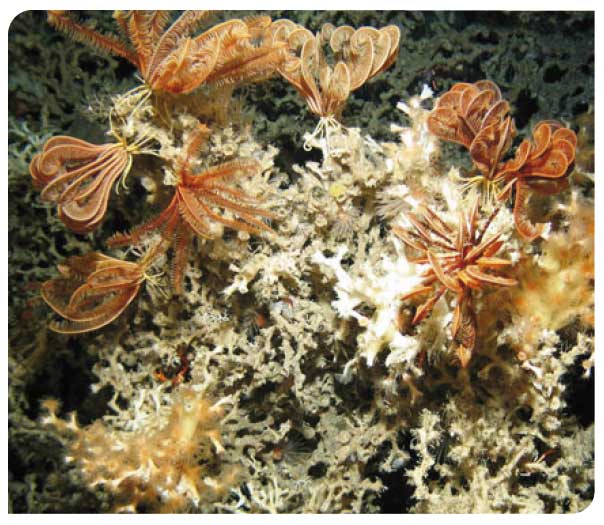Scotland's Marine Atlas: Information for The National Marine Plan
Scotland's Marine Atlas is an assessment of the condition of Scotland's seas, based on scientific evidence from data and analysis and supported by expert judgement.
DEEP SEA HABITATS
| These are habitats occurring beyond the continental shelf break at depths typically greater than around 200m. Knowledge of these habitats is very patchy and limited but is growing all the time, revealing more and more about the rich diversity of life found in the deep waters off Scotland. These habitats are found almost entirely to the north and west of Scotland and comprise cold water coral reefs, coral carbonate mounds, submarine canyons, sea mounts and deep sea sediments. There is relatively little abyssal plain habitat within the boundaries of Scottish waters. Priority marine features Seamount communities
|
|
|
| Seamount communities
Pressures Demersal and pelagic trawling, long-lining and deep sea mining all pose threats to seamounts. |
|
|
| These are typically steep-sided mounds that may be up to 350m high, formed from the debris of cold water coral reefs occurring at depths of between 500 and 1100m. They support a diverse community comprising echiuran worms, sponges, bryozoans, soft corals, ascidians, tube worms, crinoids and bivalve molluscs. They are known to occur on the Hatton Bank in the far west of Scottish waters but have a wider distribution in the north-east Atlantic such as the Porcupine Bank and the Rockall Trough. Pressures These carbonate mound communities are particularly vulnerable to demersal trawling activities. |
|
|
| These are highly diverse habitats comprising dense aggregations of corals which may reach densities of between 100 and 700 colonies per 100m 2. Coral gardens can occur on both soft and hard substrate. They favour areas where there is a moderate to strong current and include solitary hard corals, sea pens, bamboo coral, gorgonians, hydro-corals and black coral. The associated fauna is also biodiverse comprising basket stars, brittlestars, featherstars, molluscs, crustaceans and various fish species. At present in Scottish waters they are known principally from the Anton Dohrn sea mount but further surveys are likely to discover new locations. Pressures Like most coral communities these are likely to be sensitive to demersal trawling activities and the effects of smothering. © JNCC |
|
|
| Deep sea sponge aggregations are found on both hard and soft substrates at depths of between 250 and 1300m; ancient iceberg plough marks are an ideal habitat as the stable boulders and cobbles provide numerous attachment points for the sponges. They are composed principally of glass sponges and the giant sponges ( Desmospongia). The spicules from dead sponges that cover the seabed inhibit the colonisation of the sediments by burrowing animals but the sponges provide an ideal attachment point for brittlestars lifting them above the sea bed where they can catch passing food particles. At present these aggregations are known from the Faroe-Shetland channel at around 500m deep and also occur in the Porcupine Seabight in the north-west Atlantic. Pressures Physical disturbance to the seabed from demersal trawling may cause direct damage to these communities along with the associated increase in turbidity and subsequent sedimentation. They are also potentially vulnerable to pollution from oil and gas operations and from bio-prospecting. |
|
|
| This is one of the most widespread and common habitats in the Scottish offshore environment occurring at depths of between 200 and 500m. It supports a community of burrowing animals such as Dublin Bay prawns ( Nephrops norvegicus), polychaete worms, bivalve molluscs, brittlestars and foraminifera (the latter are an important potential early indicator of the impacts of ocean acidification). Pressures Deep sea muds are threatened by demersal fishing operations for Nephrops and other deepsea species that can lead to disturbance of the sea bed. Anchoring in oil and gas developments, cables and pipelines and deep sea mining also pose threats. |
|
|
| Cold-water coral reefs A large proportion of the global records of Lophelia pertusa are from Scottish waters on the continental slope beyond the shelf break, principally in the North Atlantic on the Rockall, Hatton and George Bligh Banks, on Anton Dohrn and Rosemary Bank seamounts and the Wyville-Thomson Ridge as well as the Darwin Mounds. A significant reef has recently been discovered in the Minches off Mingulay in relatively shallow water at around 110m depth. Pressures Lophelia reefs are threatened by demersal trawling operations, smothering and pollution. |
|
|
| Lophelia pertusa |
Cold water coral reefs |
|
There is a problem
Thanks for your feedback
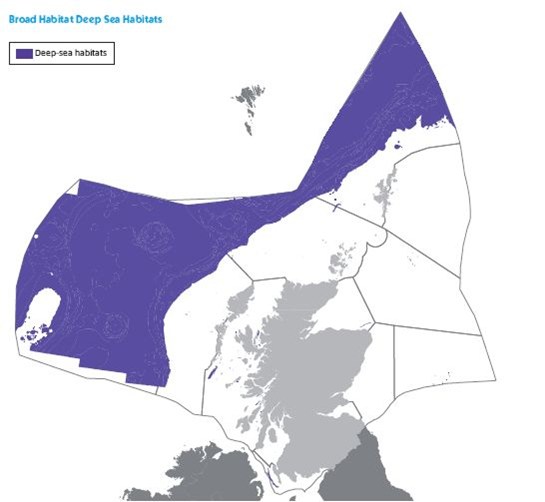 Deep Sea Habitats
Deep Sea Habitats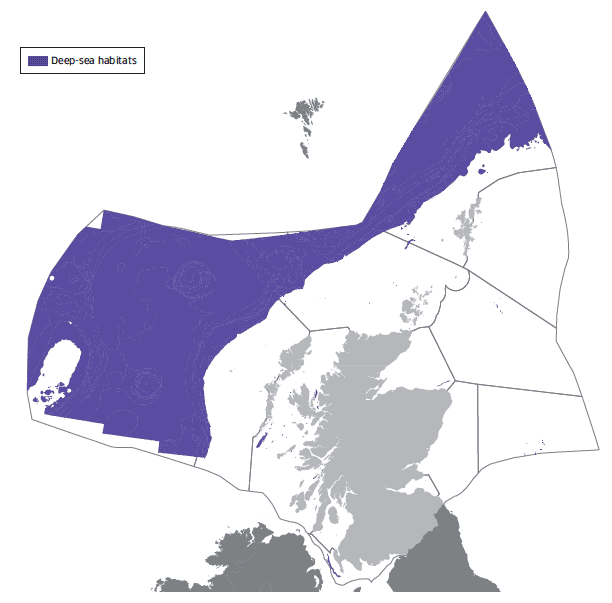
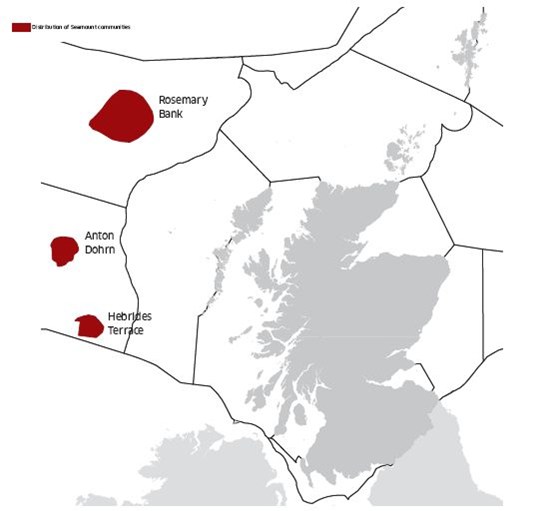 Seamounts are undersea volcanic mountains that can rise up to 1000m from the sea bed. They have relatively diverse biota in comparison to the surrounding sea bed supporting corals, sponges, hydroids and sea squirts as well as various commercial fish species such as orange roughy. They also act as a focal point for many top predators such as sharks, rays, tuna and swordfish as well as various cetaceans including bottlenose, common and spotted dolphins. There are a large number of seamounts across the Mid-Atlantic ridge but the main ones in Scottish waters are Anton Dohrn, Rosemary Bank and the Hebrides Terrace.
Seamounts are undersea volcanic mountains that can rise up to 1000m from the sea bed. They have relatively diverse biota in comparison to the surrounding sea bed supporting corals, sponges, hydroids and sea squirts as well as various commercial fish species such as orange roughy. They also act as a focal point for many top predators such as sharks, rays, tuna and swordfish as well as various cetaceans including bottlenose, common and spotted dolphins. There are a large number of seamounts across the Mid-Atlantic ridge but the main ones in Scottish waters are Anton Dohrn, Rosemary Bank and the Hebrides Terrace.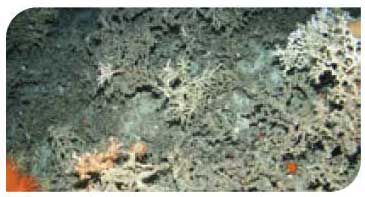
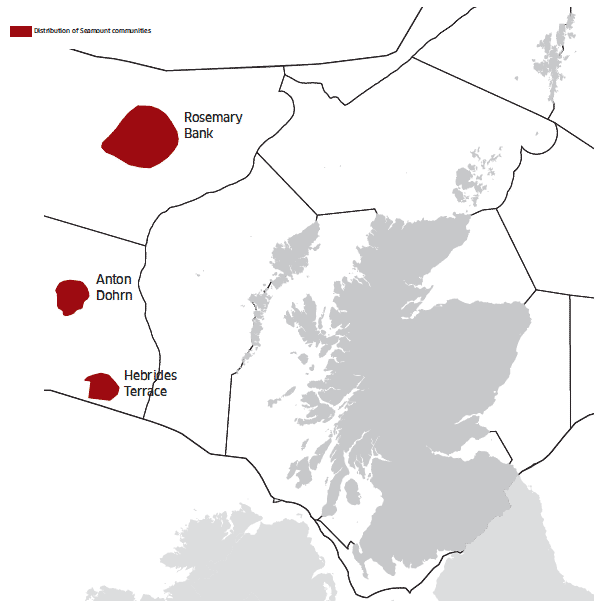
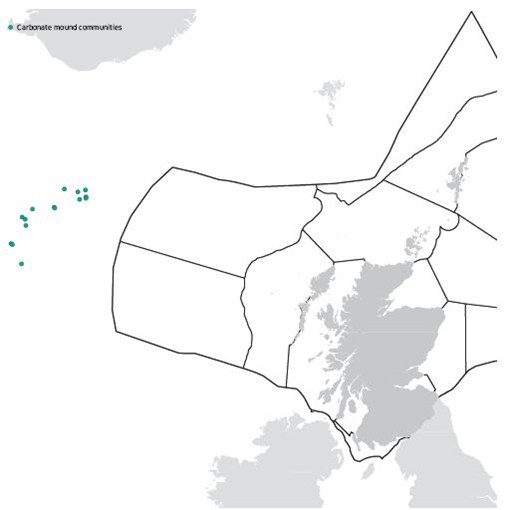 Carbonate mound communities
Carbonate mound communities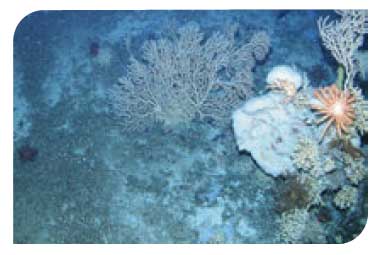
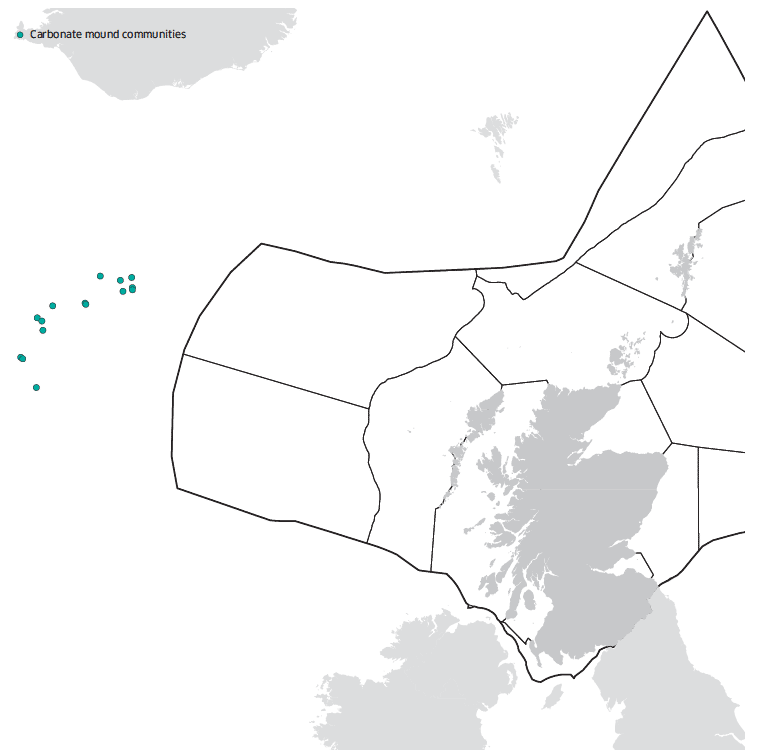
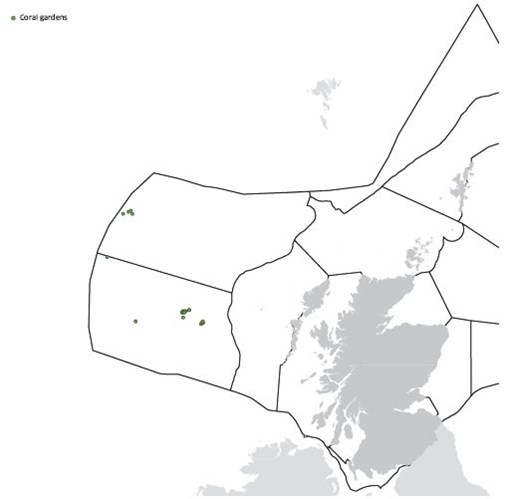 Coral gardens
Coral gardens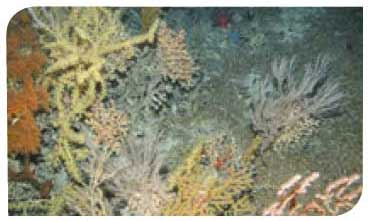
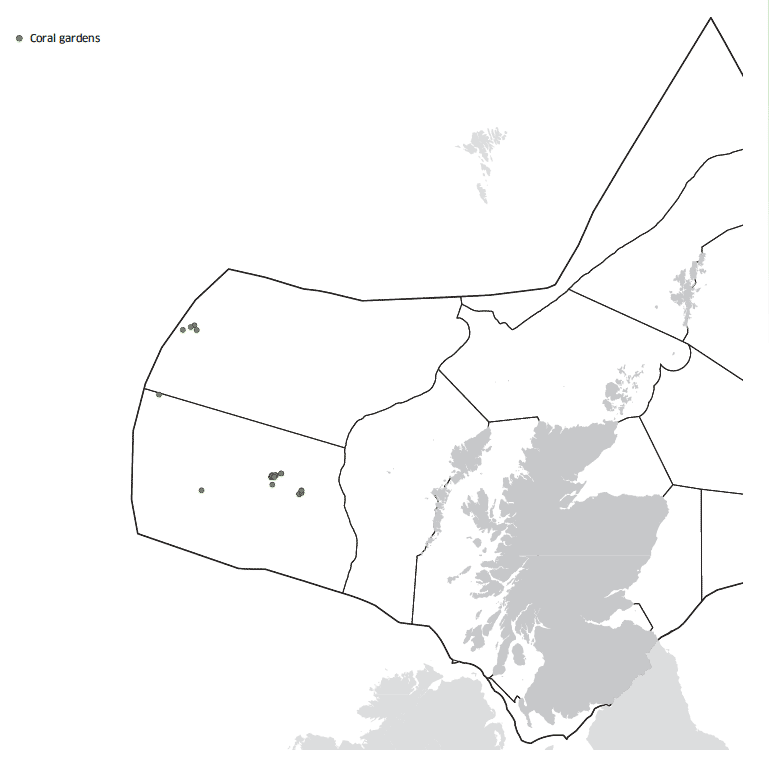
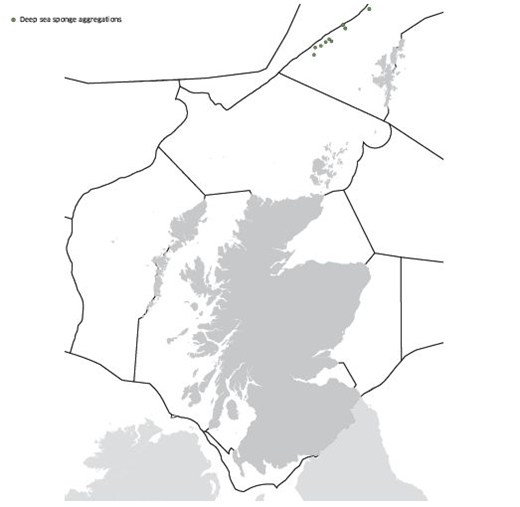 Deep sea sponge aggregations
Deep sea sponge aggregations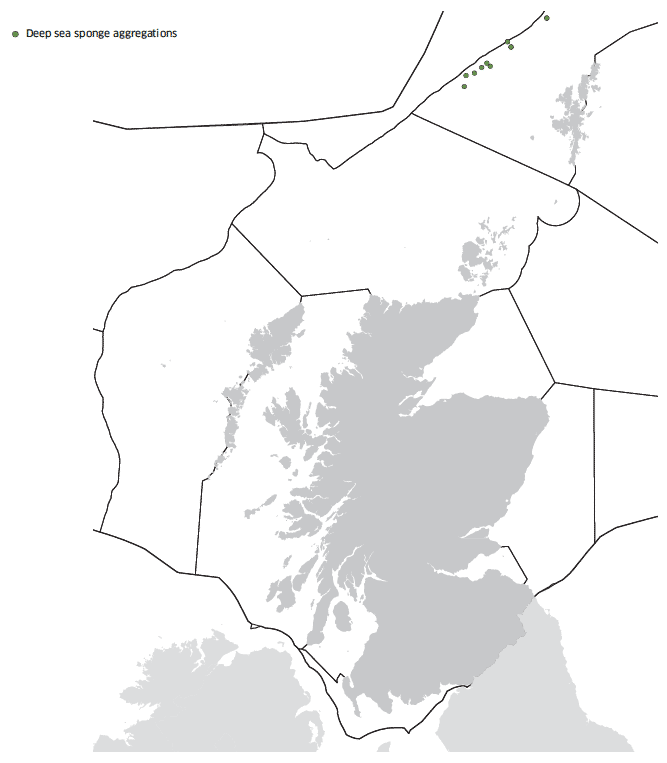
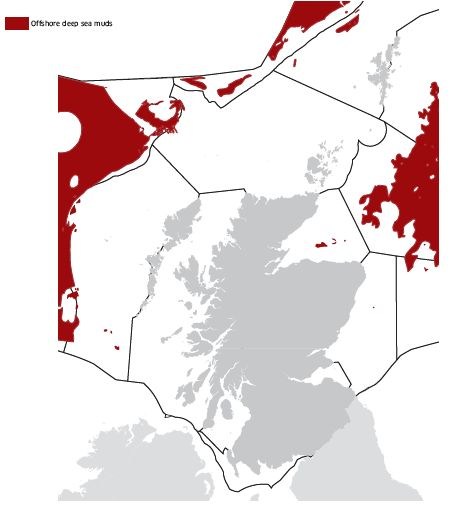 Offshore deep sea muds
Offshore deep sea muds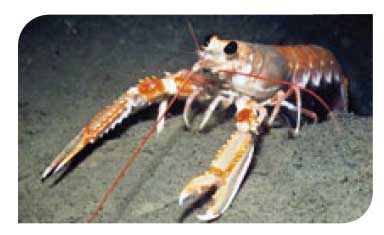
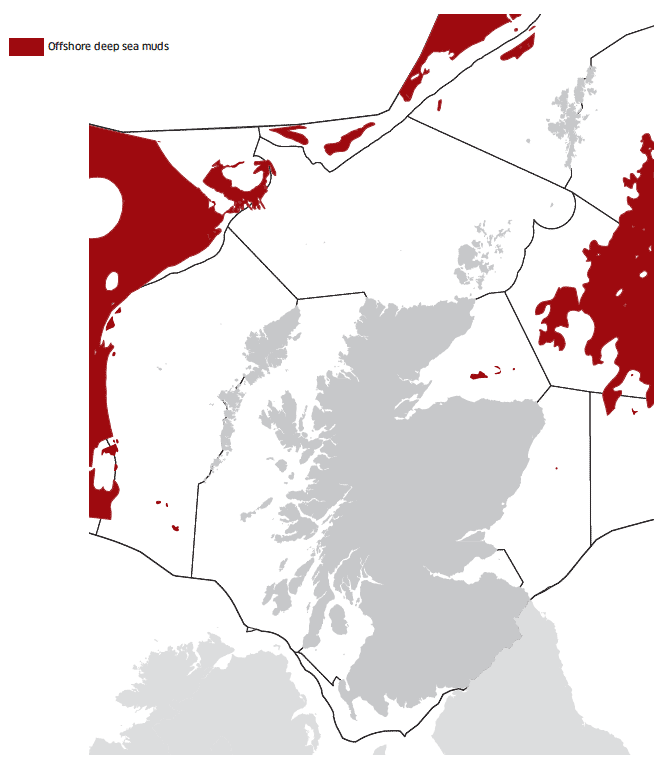
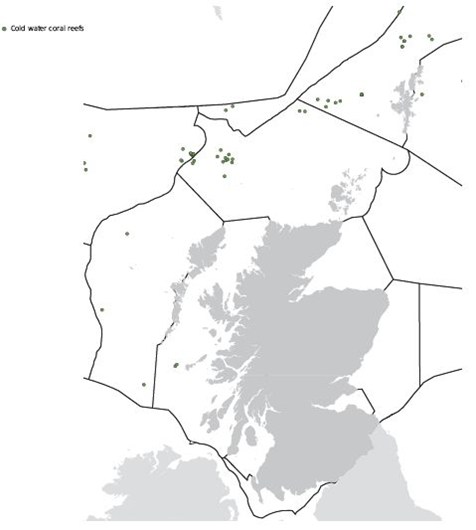 Reefs of the hard, cold water coral Lophelia pertusa in association with other hard corals (e.g. Madrepora oculata and Solenosmilia variabilis) are found in water between 130 and 2000m depths, and can cover extensive areas of the sea bed up to several kilometres long and standing more than 20m high. The oldest of these reefs are estimated to be around 8000 years old. The reef structure provides shelter and an attachment surface for a wide range of species; over 1300 different species have been found living associated with Lophelia reefs in the North Atlantic including extremely rich assemblages of starfish, sea urchins, anemones and sponges. They also attract a wide range of mobile species such as red fish ( Sebastes spp.), ling ( Molva molva) and tusk ( Brosme brosme), some of which are important commercial species. This has resulted in some reefs being seriously damaged by fishing gear as the industry has increasingly targeted these deep water species.
Reefs of the hard, cold water coral Lophelia pertusa in association with other hard corals (e.g. Madrepora oculata and Solenosmilia variabilis) are found in water between 130 and 2000m depths, and can cover extensive areas of the sea bed up to several kilometres long and standing more than 20m high. The oldest of these reefs are estimated to be around 8000 years old. The reef structure provides shelter and an attachment surface for a wide range of species; over 1300 different species have been found living associated with Lophelia reefs in the North Atlantic including extremely rich assemblages of starfish, sea urchins, anemones and sponges. They also attract a wide range of mobile species such as red fish ( Sebastes spp.), ling ( Molva molva) and tusk ( Brosme brosme), some of which are important commercial species. This has resulted in some reefs being seriously damaged by fishing gear as the industry has increasingly targeted these deep water species.